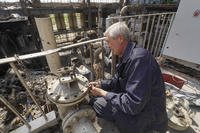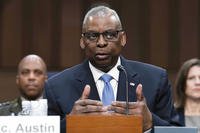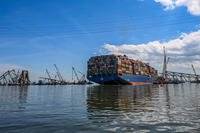Joseph V. Micallef is a best-selling military history and world affairs author, and keynote speaker.
Between February and September 2017, North Korea conducted 15 tests involving 22 missiles -- an average of almost one test every two weeks. Those tests were designed to test the missiles' engines, guidance systems, range and re-entry vehicles.
At the same time, Pyongyang declared that it had successfully miniaturized a nuclear warhead to fit it into the nose cone of a missile, although it did not offer any tangible proof of this.
It also declared that it was considering an atmospheric nuclear test, the first such test by a nuclear armed country in half a century. Its last underground test, its sixth since 2006, occurred on Sept. 3, 2017.
Concurrently, the Trump administration has continued to send mixed signals about its intentions and its assessment of the crisis.
Secretary of State Rex Tillerson and Defense Secretary Jim Mattis have continued to insist that the U.S. is searching for a diplomatic solution despite public statements and tweets from President Donald Trump that "it's a waste of time" to engage North Korea diplomatically.
U.S. officials have met, at least several times, with North Korean diplomats at its U.N. Mission and appear to have also utilized other back channels to speak directly to the North Korean government.
In the meantime, for the first time since 2007, the U.S. -- on the pretext of conducting military drills with its Asian allies -- has moved three carrier task groups -- the Ronald Reagan, Nimitz and Theodore Roosevelt -- into the western Pacific to demonstrate the Navy's ability "to operate multiple carrier task groups as a coordinated effort."
It has beefed up its offensive capabilities in the region and conducted a series of bombing drills over the Korean peninsula.
All the while, the Trump administration has alternatively criticized Beijing for not doing enough to rein in North Korean leader Kim Jong-un and then praised it for the role it has played so far.
Imposing Sanctions
On Aug. 5, 2017, the U.N. Security Council passed Resolution 2371 in response to the multiple missile tests that North Korea conducted during July. The new resolution bans imports of North Korean coal, iron, lead and seafood. The sanctions affected around $1 billion of North Korean exports, roughly about one-third of its total foreign sales.
The U.N. sanctions were in addition to separate U.S. sanctions aimed at crippling the North Korean regime.
In July 2017, in response to the death of American college student Otto Warmbier, the U.S. forbade American citizens from visiting North Korea.
On Aug. 2, Trump signed into law the "Countering America's Adversaries Through Sanctions Act" (H.R. 3364), which imposed additional sanctions on North Korea, Iran and Russia.
On Sept. 21, 2017, Trump issued an executive order allowing the Treasury Department to cut off from the U.S. financial system or to freeze the assets of any company, business, organization and officials trading in goods, services or technologies with North Korea. Four days later, the White House issued an executive order "banning entry of North Korean nationals into the U.S."
The European Union, Australia and Japan, among others, have also imposed similar sanctions against Pyongyang.
On Sept. 11, 2017, the U.N. Security Council passed a second set of sanctions, Resolution 2375, imposing limits on North Korean imports of crude oil and refined petroleum products. The U.S. had lobbied for a complete ban on North Korean oil imports, virtually all of which come from China, but had to settle for a partial ban.
The sanctions prohibited any new joint ventures between North Korea and any other country. It also banned exports of textiles and prohibited imports of natural gas condensates and other hydrocarbons. Finally, the sanctions also froze the number of North Korean workers allowed to work overseas.
In the meantime, Trump and Kim Jong-un continued to trade insults with one another. The most recent exchange occurred over the weekend of Nov. 10, when North Korean state media described Trump as "old" and a "destroyer," and characterized his 12-day Asian tour as "a warmonger's trip for confrontation."
Meanwhile Trump dismissed Kim Jong-un, suggesting in a backhanded way that he was "short and fat."
Having an Effect?
Pyongyang's lack of any further missile tests might be in response to Chinese pressure to avoid confrontational actions during the Chinese Communist Party's recently completed 19th National Congress.
It might also reflect the impact of the last round of sanctions. While it appears that some of those sanctions are being circumvented by Chinese companies, enough of the sanctions are being enforced to cause considerable damage to North Korea's economy.
The recent geologic instability of Mount Mantap at the North Korean atomic testing site in Punggye-ri may also be a factor.
The collapse of some of the tunnels inside the mountain where atomic bomb tests have been conducted have raised fears that the mountain could collapse, in the process releasing radioactive contamination. While the stability of the mountain would hamper additional atomic bomb tests, it should not in theory affect any new missile tests.
It's also possible that Pyongyang is genuinely concerned about the prospect of unilateral U.S. military action and has concluded that Trump is unpredictable and a loose cannon.
In that case, what may appear as policy incoherence from the Trump administration might turn out to be a carefully crafted good cop/bad cop routine, with Tillerson and Mattis playing the role of the good cops and Trump that of the bad cop.
There is one other explanation worth considering. Over the last several months, there have been consistent reports of a rise in public protests of the Kim regime. These protests have taken the form of acts of vandalism against monuments to the Kim family.
Pyongyang appears to be sufficiently concerned about the vandalism that it has mobilized police and military units to guard statues and paintings of Kim Jong-un and those of his father Kim Jong-il and his grandfather Kim Il-sung.
While such actions fall far short of a public uprising, they are unprecedented in North Korea. Vandalism against monuments to the Kim family would be punishable by immediate execution.
Moreover, under North Korea's "three generations of punishment rule," both the parents and the children of any would-be vandal would be punished by execution or imprisonment as would, most likely, the members of their extended family. A high price to pay for scrawling a little graffiti.
Such acts of vandalism could be the result of spontaneous protests by North Koreans fed up with the rampant poverty and oppression of life in the north. They are also a signal to North Koreans that there is an opposition to the Kim regime forming.
In the past, Pyongyang was quick to crush any sign of public unrest among North Koreans. Historically, potential challenges to the rule of the Kim family came from the North Korean elite themselves, typically from other branches of the Kim family or senior officials in the government.
Since coming to power in 2012, Kim Jong-un has carried out the executions, often by gruesome means, of four family members and three senior government officials.
Fostering Regime Change?
It's also possible that this "spontaneous unrest" might indicate a deliberate attempt at encouraging and organizing regime change by an outside party.
There are only three actors that would possibly orchestrate an attempt at regime change in North Korea: South Korea, China and the United States. It's unlikely that South Korea, under its present government, would try to replace the Kim family's rule in North Korea. Such an action would entail high risks for Seoul.
Moreover, the present orientation of the South Korean government leans toward engagement with the north and a search for a peaceful solution to the crisis. Actively fostering regime change would run counter to Seoul's current policies.
If an attempt at regime change is in the offing, only China and the U.S. would be the likely instigators. Moreover, such a gambit would require Washington and Beijing to have a consensus on what portions of the status quo in the Korean peninsula would be maintained.
Beijing does not want to see the political unification of the Korean peninsula under the leadership of South Korea. It prefers to keep North Korea as a buffer between itself and South Korea and the U.S. troops stationed there.
In the past, China has been willing to tolerate the antics of the Kim dynasty because the alternative would have been a power vacuum in the north that could have led to collapse and eventual unification with the south.
Beijing is in an ideal position to encourage regime change in North Korea, but it would do so only if it had a firm understanding with the U.S. that neither it nor South Korea would attempt to take advantage of any resulting turmoil in North Korea to seek political unification.
In other words, China would insist on a commitment from the U.S. that a communist North Korean state, albeit under different leadership, would continue to act as a buffer between South Korea and China and that it would remain under the control of the Workers' Party of Korea (WPK). Such a consensus would be required regardless of which party was instigating a regime change.
Risky Strategy
Such a strategy is risky, since there is the danger that, if he fears he will lose power, Kim Jong-un might decide to roll the dice and launch an attack on South Korea or even the United States.
On the other hand, it is less risky than leaving Kim Jong-un in power indefinitely, with the danger that a North Korean provocation or a pre-emptive U.S. strike against Pyongyang would precipitate the outbreak of a general war on the Korean peninsula.
Despite the Trump administration's steady drumbeat "that all options are on the table," it's unclear if a military solution is even possible as long as the South Korean government opposes unilateral military action.
It's highly doubtful that the U.S. would launch any kind of attack against North Korea unless Seoul was fully aligned with Washington on the need for a military strike. To date, South Korea has been unwilling to give its consent to a pre-emptive military attack.
It's possible that Kim Jong-un has concluded that he has overplayed his hand and is looking to de-escalate the crisis, although outwardly he is still maintaining some of the rhetoric, before regime change becomes a viable option.
It's also possible that Pyongyang will simply announce that its nuclear development program is a success and that it has finished the development and testing phase of its missile program, gambling that the U.S. will ultimately not act unilaterally.
It might also be the case that Washington and Beijing have come to an understanding that the only way to avert a war on the Korean peninsula long-term is to replace the Kim regime and that both countries, primarily China, are hard at work to bring that about.
If that's the case, that may well explain why any talk from Washington about China's unfair economic policies has virtually disappeared over the last few months.
Either way, this crisis is far from over. The final act might well surprise us all.
-- The opinions expressed in this op-ed are those of the author and do not necessarily reflect the views of Military.com. If you would like to submit your own commentary, please send your article to opinions@military.com for consideration.













